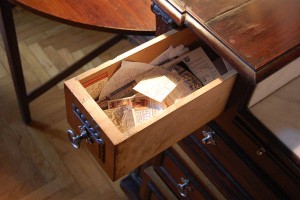Here are a few more answers to questions posted by readers of this blog:
Question: Have you thought about offering electronic versions of your books–perhaps as a value-added download from the site for those who purchase the paper copies?
Answer: My publisher (who’s very enthusiastic about these things) has produced a few prototype electronic versions of my books, and we are open to this. But I think the electronic guidebook needs to be cleverly designed beyond simply offering the same page layouts as the printed versions. I think the business model is yet to be developed.
Question: OK, Rick, we know how you pack, but how does your wife, Anne, pack? It would be nice to hear the female Steves version of packing light.
Answer: My wife travels with the same size bag I do (but the wheeled version). I’m traveling this week with a woman from my office (Heidi Sewell, a great Italian tour guide who speaks Italian so well locals think she’s from Bologna). Just today, as we transferred from Venice to Padua, I marveled at how mobile a good woman traveler can be. (I felt sexist to have doubted it.) Heidi (like all the women in my office…and at home) travels with a 9 by 22 by 14 inch wheeled bag. Whether going for two weeks or two months, you pack precisely the same.
Question: Do you always identify who you are when researching or do you go incognito?
Answer: I not only go incognito, I try to go stupid…as a gawky, tightwad, English-only tourist, in order to get a sense of how the clumsiest tourist will be received in a hotel or restaurant. Yesterday we dropped incognito into a recommended bar for a glass of wine and plate of fried vegetables — and were overcharged. That place will not be in the 2008 edition of my book. Most hotels and restaurants I recommend now know who I am. (I send many of them Christmas cards with my family photo each year — not to mention probably a third of their American business.) My best tool is talking to other people who have already eaten or slept there to learn if the recommendation is a good one. For restaurants, my standard operating procedure lately is to blitz known and unknown places from 8 to 10 p.m., and then drop into my favorite (which is often run by someone who by now is a friend) and just say, “Feed me — bring me a sampling of your most interesting dishes.” It’s always a great cap to a great day.
Question: Any interest on your part to relocate to Europe one day or buying property? Wouldn’t it be easier if you had a second home?
Answer: I once flirted with buying a little place in Civita di Bagnoregio, Italy’s ultimate hill town. It was a dreamy little home perched on the edge of a grand canyon with several floors of Etruscan cellars below. With each visit (on successive tours…so every three weeks, all summer), I’d get the real-estate agent and fantasize about owning it. Then, thankfully, someone else bought it. I believe there’s also a great chalet for sale in Gimmelwald (my favorite Swiss alpine village) for around $250,000 — what a dream to have a place there! But I don’t want a single place in Europe. I sleep in about 60 different hotels in about 60 wonderful towns and villages all over Europe each year. (And I already have one cabin — in the Cascades — that I only use a couple times a year.)


